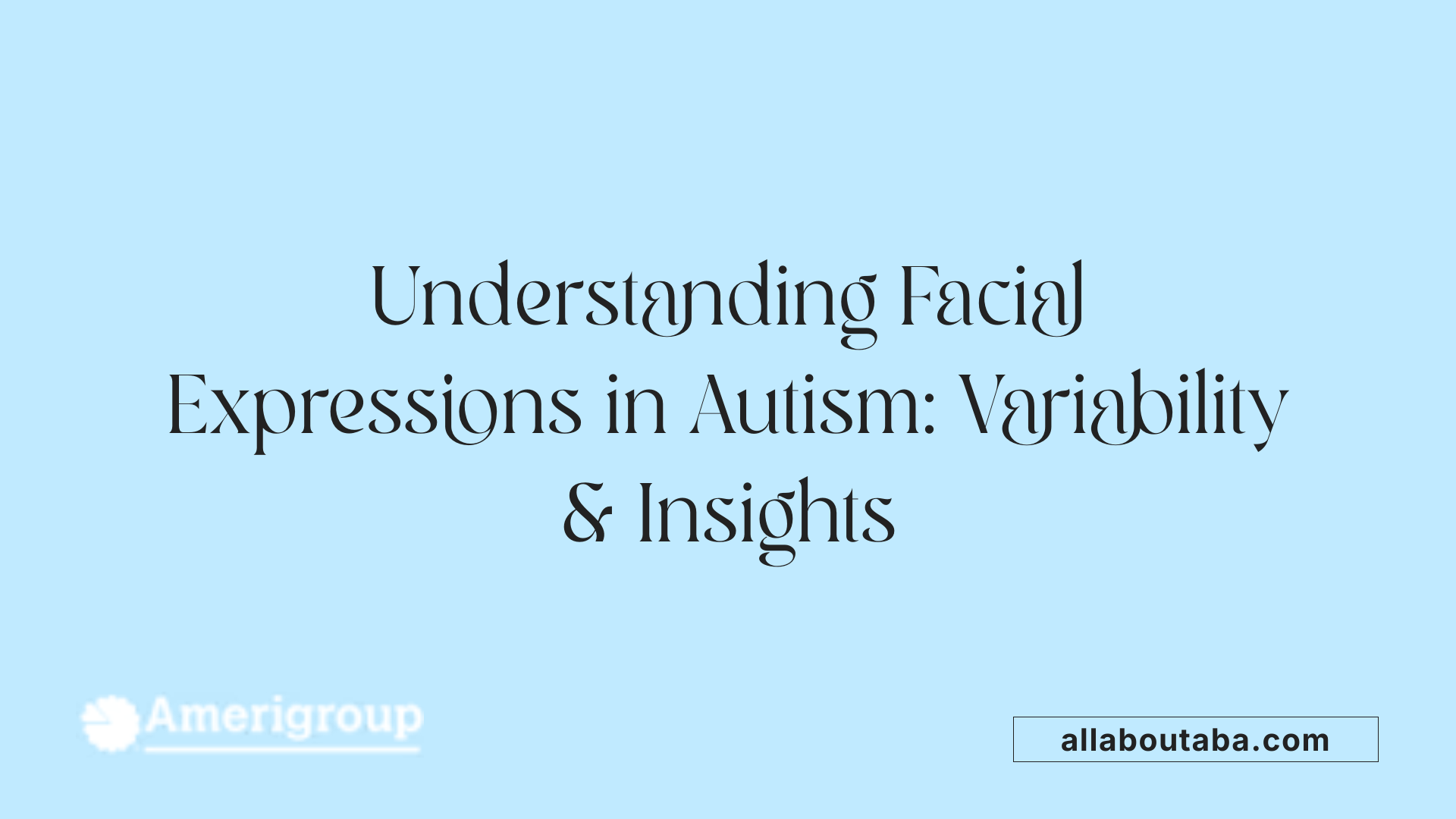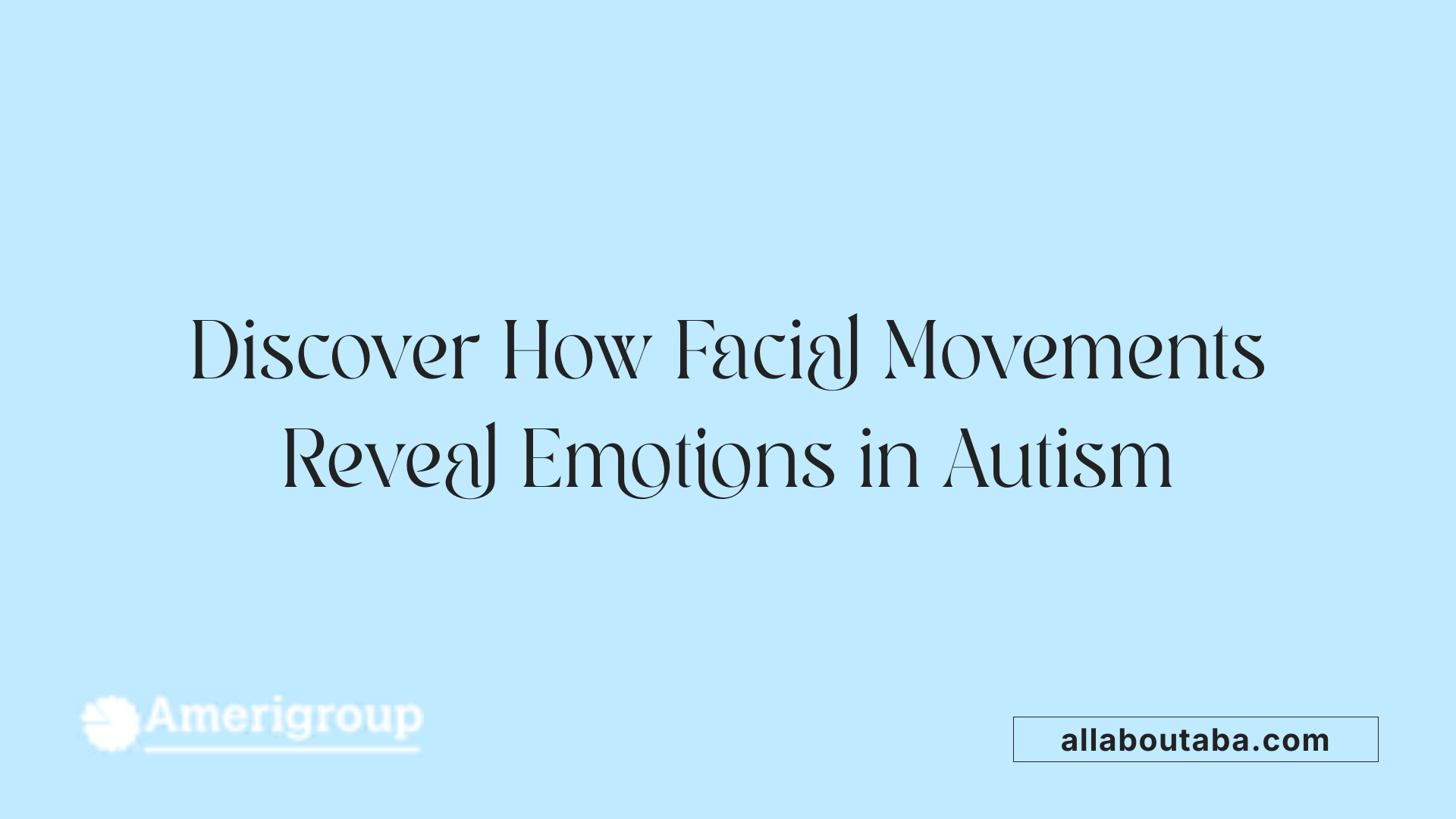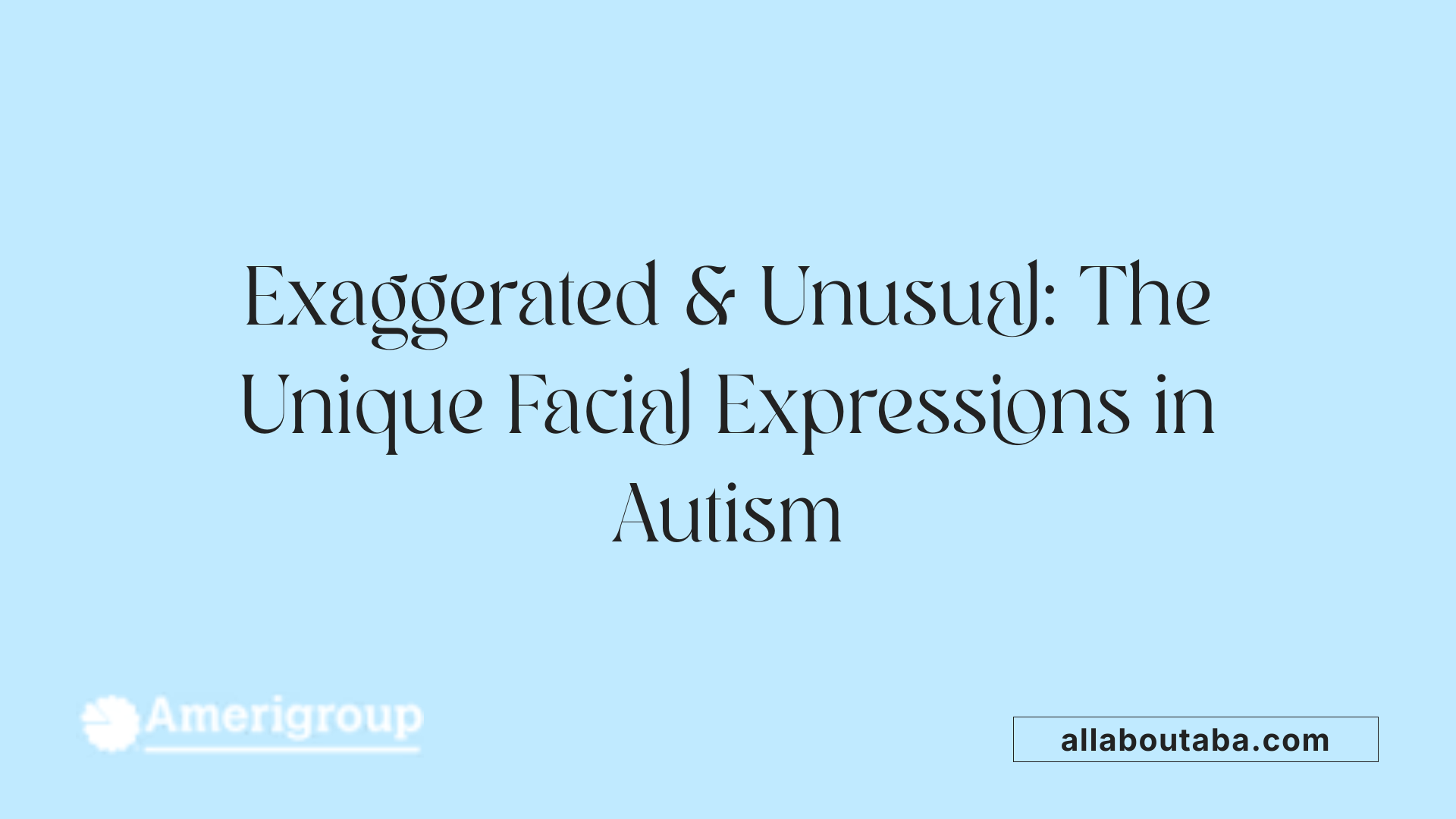Understanding Facial Expressions in Autism Spectrum Disorder
Facial expressions are vital for effective social communication, offering cues about a person's emotional state. In autism spectrum disorder (ASD), these expressions often present unique patterns—sometimes appearing overly intense, atypical, or less natural—posing challenges for both individuals with autism and those they interact with. Recent scientific advances have shed light on the underlying mechanisms of these differences, opening pathways for better understanding, diagnosis, and support.
Common Facial Expressions in Autism and Their Variability

What are common facial expressions observed in individuals with autism?
People with autism spectrum disorder (ASD) often display distinctive facial expression patterns that differ from neurotypical individuals. A prevalent feature is reduced eye contact and unusual gaze behaviors, which can impact social communication. Many autistic individuals show less frequent smiling and less expressive facial reactions, which may make their internal emotional states harder to read.
In addition, some facial responses may seem atypical or exaggerated, like overly intense or unusual laughing or smiling. These expressions might not always match what they are feeling inside, leading to perceptions that their responses are odd or out of context.
It's crucial to understand that these facial expressions are part of the diverse ways autistic individuals experience emotions. They do not indicate a lack of feeling but reflect differences in how emotions are expressed and perceived. Variations among individuals are significant, with some showing more typical expressions and others exhibiting highly idiosyncratic responses.
Overall, facial expressions in autism are characterized by a mix of reduced expressiveness, atypical reactions, and variability across individuals, all influenced by differences in emotional processing and social interaction.
Can autistic individuals recognize and interpret facial expressions of emotion?
Autistic individuals often face challenges in recognizing and interpreting facial expressions, which can hinder social understanding. This difficulty is linked to atypical internal representations of emotional cues, making it hard for them to pick up on subtle facial signals.
Recent advances in technology, including machine learning and AI tools, are helping researchers analyze tiny facial movements—called micromovements—that reveal subtle or micro-emotions often missed by the naked eye. These studies suggest that while the basic facial muscles used to express emotions are similar in autistic and non-autistic individuals, the intensity and clarity of these expressions tend to be less perceptible in ASD.
This subtlety in facial movements can cause facial expressions of autistic individuals to fall outside the common recognition range, leading to missed social cues by others. Recognizing these differences can improve understanding and communication, making social interactions more effective for autistic people.
Variability of facial expressiveness among individuals with autism
Facial expressiveness varies widely among those with autism. Some might produce typical spontaneous smiles or frowns but with less intensity, while others may produce fewer or less typical reactions overall. Studies show that as autistic individuals age or when they have higher intellectual functioning, their facial expressions tend to become more similar to neurotypical patterns, possibly due to learned compensatory strategies.
Research using new tools like micromovement spikes has further demonstrated that all autistic individuals possess the muscle movements necessary for expressing emotions. The difference lies mostly in how intense or perceptible these expressions are, not in their existence.
While facial expressions can be less natural or more idiosyncratic, emphasizing the importance of understanding the emotional context can help improve social interactions. Recognizing that atypical expressions are linked to differences in internal emotional representation rather than a lack of feeling fosters greater acceptance and tailored support.
| Aspect | Typical vs. Autism | Explanation |
|---|---|---|
| Frequency of facial expressions | Greater variability | Some autistics may produce fewer spontaneous expressions |
| Intensity of expressions | Less intense | Autistic faces often show less vivid emotional cues |
| Recognizability | Reduced | Expressions often fall outside the usual recognition range |
| Response to stimuli | Similar response speed | Still respond quickly but with less typical expression |
| Development over age | Improves | Expressions become more typical with age and support |
This growing understanding highlights that differences in facial expressions in ASD are primarily about expression intensity and recognition, not emotional capacity. Continued research aims to improve recognition methods, helping autistic individuals communicate more effectively.
Scientific Insights into Facial Movements and Emotion Recognition

What is the significance of facial grimacing in autism?
Facial grimacing in autism can involve repetitive or exaggerated facial movements, such as squinting or grimacing, which may be linked to motor tics or involuntary responses. These expressions are sometimes associated with sensory processing differences or neurological aspects of autism.
Research on facial movements in autism
Recent studies have explored subtle facial movements to better understand how autistic individuals express emotions. Using innovative techniques like micromovement spikes—tiny, microscopic facial motions—researchers can detect how autistic individuals convey emotions, which often occurs at a less perceptible intensity compared to neurotypical individuals.
In a notable Rutgers-led study, researchers found that while the basic facial movements for emotions like anger and disgust are similar in both autistic and non-autistic people, the intensity often falls outside typical detection ranges in autistic individuals. This subtlety can make their facial expressions harder to interpret, affecting social communication.
Accuracy of emotion recognition by raters
Studies show that raters can identify the emotions of people with autism more accurately than those without ASD when the expressions are evoked through realistic methods. Interestingly, raters tend to recognize emotional cues in autistic faces better than in posed photographs, emphasizing the importance of naturalistic expressions.
However, autistic expressions are generally rated as less natural and more intense—sometimes perceived as awkward—due to differences in how emotions are expressed. Despite these challenges, researchers have found that raters are often better at perceiving the emotions that autistic individuals are trying to convey, suggesting an awareness of subtle emotional cues.
Differences in expression intensity and naturalness
Although individuals with autism experience emotions as vividly as others, their facial expressions tend to be less typical, more intense, or unconventional. They often produce fewer spontaneous expressions, and the expressions they do produce can seem exaggerated or unnatural.
Moreover, these differences can impact social interactions, as unfamiliar or overly intense expressions might be perceived as awkward or confusing. Autistic individuals also tend to mimic fewer facial expressions and find it difficult to produce appropriate responses to social cues.
Use of advanced technology in studying facial expressions
Advances in technology, particularly machine learning and AI, have revolutionized the study of facial expressions in autism. Tools such as smartphone cameras combined with AI algorithms can analyze facial micromovements, providing a detailed and scalable approach to understanding emotional expressions.
In addition to facial analysis, these technologies help identify subtle facial motions that escape the human eye. Such insights can improve diagnosis and support systems by recognizing emotional states more accurately, even when they are expressed subtly or idiosyncratically.
Implications for social understanding
The findings highlight that autistic individuals use the same fundamental facial movements as others to communicate emotions, but often differ in intensity and naturalness. These differences do not stem from a lack of awareness of emotions but often relate to how internal representations of expressions develop.
Suggestions for improving social interactions include emphasizing the communicative function of facial expressions and providing visual feedback to help autistic individuals produce more recognizable expressions. Overall, combining technological tools with behavioral insights offers promising pathways to better understand and support emotional communication in autism.
Exaggerated and Unusual Facial Expressions in Autism
 Individuals with autism spectrum disorder (ASD) often display facial expressions that are more intense, unusual, or overly expressive compared to neurotypical individuals. These expressions can appear exaggerated, awkward, or unnatural, which can make social interactions challenging. While autistic adults have the capacity to experience emotions as richly as others, their facial expressions may seem out of sync with their emotional states.
Individuals with autism spectrum disorder (ASD) often display facial expressions that are more intense, unusual, or overly expressive compared to neurotypical individuals. These expressions can appear exaggerated, awkward, or unnatural, which can make social interactions challenging. While autistic adults have the capacity to experience emotions as richly as others, their facial expressions may seem out of sync with their emotional states.
Research indicates that autistic facial expressions tend to be less natural and more intense, with some individuals showing heightened spontaneous expressions, regardless of emotional valence. Others may produce fewer spontaneous expressions or produce looks that are difficult for others to interpret. This variability is not simply a matter of being less expressive but involves complex differences in how emotions are visually communicated.
Studies have found that the facial expressions of people with autism—even when they produce smiles or frowns—are often of similar intensity to those of neurotypical controls. However, these expressions tend to be less typical and are produced less frequently. For example, while autistic individuals can respond quickly to stimuli, they tend to generate fewer spontaneous facial responses, which impacts social understanding.
The differences in facial expressivity are also related to developmental factors. As autistic individuals age or attain higher intellectual functioning, they often develop compensatory strategies that make their expressions more typical. Nonetheless, subtle differences often remain, primarily related to how intense or natural these expressions appear.
Recent technological advancements, like machine learning and facial movement analysis, have been crucial in uncovering these nuances. Researchers now analyze tiny facial movements—called micromovement spikes—to detect subtle emotional expressions that might be overlooked by the human eye. These tools reveal that while the facial muscles involved in expressing emotions are active in both autistic and neurotypical groups, the expressions in autistic individuals tend to be less perceptible in intensity.
Such differences can impact social communication, as facial expressions outside the usual range may lead others to miss important social cues. This disconnect is compounded by the fact that autistic expressions are often idiosyncratic and not systematically shared among individuals with ASD, making recognition even harder for other autistic people and non-autistic observers alike.
Additionally, facial expressions are influenced by contextual cues such as body posture, which can distort perception further. Both autistic and non-autistic individuals are susceptible to influence from body language, but autistic persons tend to have lower overall precision in facial expression interpretation. This can make understanding emotions based on facial cues more difficult, particularly in isolated face presentations.
In conclusion, while autistic individuals produce emotional facial movements similar in basic form to those of others, the intensity and naturalness of these expressions are often diminished. This can hinder social interactions and emotional recognition, highlighting the importance of employing advanced technology like AI and micromovement analysis to better understand and support emotional communication in autism.
The Development and Context of Facial Expressions in Autism
How do facial expressions develop in individuals with autism?
Autistic adults often display facial expressions that are more intense and less natural compared to neurotypical individuals. Despite these differences, research shows that they are capable of experiencing a rich spectrum of emotions, similar to others. Early in development, however, children with autism may have difficulty producing appropriate facial responses and tend to produce fewer spontaneous expressions.
Studies reveal that these atypical expressions often stem from differences in internal emotional representations rather than a lack of awareness or motor skills. As children with autism grow older and develop higher intellectual abilities, some of these differences decrease. They might adopt compensatory strategies that make their expressions more typical over time.
What is the relationship between internal emotional states and facial expressions?
People with autism do experience emotions just as intensely as others; however, their facial expressions can be idiosyncratic and sometimes difficult to interpret. Recent technological advances, including machine learning analysis of tiny facial movements, suggest that individuals with autism use the same basic facial movements to express emotions but tend to do so with less intensity.
This subtlety can make it challenging for others to read their emotions. The expressions often fall outside typical perceptual ranges, leading to missed social cues. Furthermore, research indicates that facial expressions are influenced by internal emotional processes and those with autism may have different internal representations of emotional cues, affecting how they communicate emotional states.
How does social context influence facial expressions in autism?
Facial expressions are heavily influenced by social and physical context. Both autistic and neurotypical individuals show a strong influence of body posture on facial expression perception. In autism, there is an increased reliance on body cues, potentially compensating for less distinct facial expressions.
Research focusing on emotions like anger and disgust demonstrates that autistic individuals tend to have reduced recognition accuracy in isolated facial presentations but recognize emotions conveyed through body posture effectively. This indicates that social cues from body language can serve as reliable sources of emotional information, somewhat offsetting challenges in facial expression recognition.
How are facial expressions assessed in autism?
Assessments such as standardized tests—like the Reading the Mind in the Eyes Test and other computer-based tasks—are used to evaluate facial emotion recognition. These tools quantify how well individuals perceive and interpret facial cues. Although testing methods vary, they are essential in understanding the degree of social communication challenges faced by autistic individuals and in developing targeted interventions.
Additional insights into facial expressions in autism
Technological innovations, notably using AI and smartphone cameras, are revolutionizing how researchers analyze facial movements. Such methods detect micro-movements, termed micromovement spikes, that reveal subtle emotional expressions often missed by the naked eye. These advancements hold promise for improving diagnosis, understanding emotional processing, and tailoring social support strategies.
| Aspect | Findings | Implications |
|---|---|---|
| Facial expression intensity | Less intense, more variable in autism | Affects perception and interpretability of emotions |
| Developmental trends | Differences decrease with age and higher cognitive functioning | Suggests potential for adaptation and compensation |
| Social influence | Body cues help convey emotions | Can be leveraged for better social understanding in autism |
| Assessment tools | Standardized tests and AI analysis | Enhance diagnostic precision and intervention planning |
| Technological methods | Micromovement detection | Provide detailed insights into emotional expressions |
Understanding how facial expressions develop and function in autism, especially within social contexts, helps create better pathways for communication and social integration. As technology advances, so does the potential to bridge the gap between emotional experience and expression, fostering more meaningful interactions for individuals with autism.
Towards Better Understanding and Support
Understanding the nuances of facial expressions in autism not only enriches our comprehension of how autistic individuals communicate but also opens avenues for improved diagnostic tools and interventions. Advancements in technology, such as machine learning and AI-based analysis of minute facial movements, are revolutionizing this field. Recognizing that the differences in facial expressivity do not reflect a lack of emotion but rather atypical internal representations or motor patterns is crucial. Supporting autistic individuals by enhancing recognition and interpretation of their facial cues can foster more inclusive social environments, reducing miscommunication and promoting empathy.
References
- Autistic Subjects' Facial Expressions Don't Always Mirror Emotions
- People with autism sometimes give ambiguous looks - The Transmitter
- Tracking Tiny Facial Movements Can Reveal Subtle Emotions in ...
- Can Neurotypical Individuals Read Autistic Facial Expressions ...
- The influence of body posture on facial expression perception in ...
- Do Babies with Autism Smile? Recognizing the Early Signs
- Do Babies with Autism Smile?







